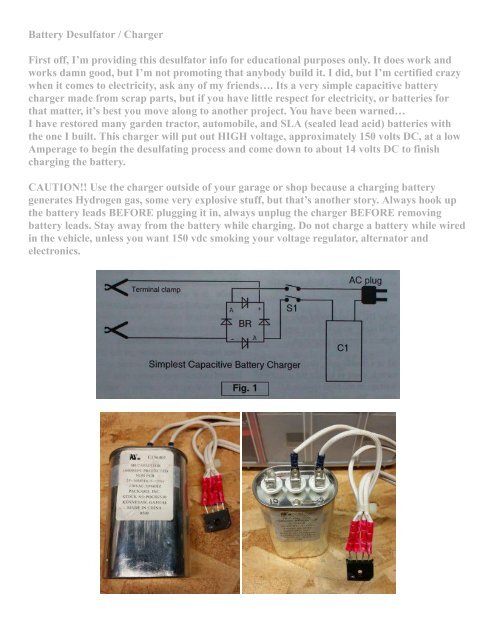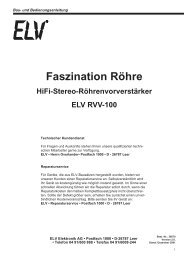Desulfator-1
You also want an ePaper? Increase the reach of your titles
YUMPU automatically turns print PDFs into web optimized ePapers that Google loves.
Battery <strong>Desulfator</strong> / Charger<br />
First off, I’m providing this desulfator info for educational purposes only. It does work and<br />
works damn good, but I’m not promoting that anybody build it. I did, but I’m certified crazy<br />
when it comes to electricity, ask any of my friends…. Its a very simple capacitive battery<br />
charger made from scrap parts, but if you have little respect for electricity, or batteries for<br />
that matter, it’s best you move along to another project. You have been warned…<br />
I have restored many garden tractor, automobile, and SLA (sealed lead acid) batteries with<br />
the one I built. This charger will put out HIGH voltage, approximately 150 volts DC, at a low<br />
Amperage to begin the desulfating process and come down to about 14 volts DC to finish<br />
charging the battery.<br />
CAUTION!! Use the charger outside of your garage or shop because a charging battery<br />
generates Hydrogen gas, some very explosive stuff, but that’s another story. Always hook up<br />
the battery leads BEFORE plugging it in, always unplug the charger BEFORE removing<br />
battery leads. Stay away from the battery while charging. Do not charge a battery while wired<br />
in the vehicle, unless you want 150 vdc smoking your voltage regulator, alternator and<br />
electronics.
I used a dual 10/25 mfd ac motor run capacitor for 1/2 or 1 amp current limiting. I used a 2<br />
amp/200 volt bridge rectifier. This charger will desulfate and charge any lead acid battery, 6,<br />
12, or 24 volt.<br />
The problem with regular battery chargers is they cannot equalize a battery or desulfate cells.<br />
Not enough electrical pressure to bust up the lead sulfate that’s insulating the cell plates.<br />
The amperage output is limited by capacitor size @ 25 mfd per amp, i.e. 25mfd/1amp,<br />
50mfd/2amp, 75mfd/3amp, etc.<br />
One more suggestion, check the battery often for overheating in case there is a shorted cell. I<br />
use a timer with mine and set it for an hour the first charge, in case I walk away and forget<br />
about it, then I step it up to 2 hours, then 3 hours, etc. until I’m comfortable that it’s taking a<br />
charge ok.



